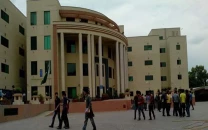K-P family planning visits post 5% drop
In 2015, some 374,812 family visits were reported by district health information system at different facilities

PHOTO: FILE
According to the 2015 data, some 374,812 family visits [birth control] were reported by the district health information system at different health facilities being run by the health department as well as family welfare centres of the population welfare department across the province.
The number of visits for the same purpose, however, has dropped to 333,252 [some 5% less than the figure recorded in 2015]. Some nine methods are being used for birth control.
USAID vows to continue to support people of Sindh
Besides other contraceptive methods, some non-government organisations distributed condoms for birth control and according to the 2015 statistics, 723,414 condoms, 112,443 combined oral contraceptive (COC) pills, 28,276 progestogen-only pills (POP) were distributed across the province.
However, the figure was found slightly lower in 2016. A total of 711,535 condoms were distributed for birth control in the year whereas the POP has also dropped to some 26,270 in 2016. COC pills’ figure, some 163,599, was however higher than that recorded in 2015.
2016 baby bump after China relaxes one-child rule
The data, a copy of which is available with The Express Tribune, stated that 38,620 opted for other preventive measures such as intra-uterine devices (IUD) which was found to be higher in 2016 as compared to 33,316 in 2015.
The number of tubal ligation also dropped since 7,018 opted for this form of contraception in 2015 whereas the statistics for 2016 read that some 3,940 opted for it.
According to documents, some 71,872 family visits were reported in 2015 from Peshawar but the number shrank to 58,298 in 2016. In Swat, some 36,768 family visits were reported in 2015 which had dropped to 32,327 in 2016. In Charsadda, the number dropped from 23,291 in 2015 to 22,103 in 2016 and in Haripur district, from 34,197 to 11,822.













COMMENTS
Comments are moderated and generally will be posted if they are on-topic and not abusive.
For more information, please see our Comments FAQ